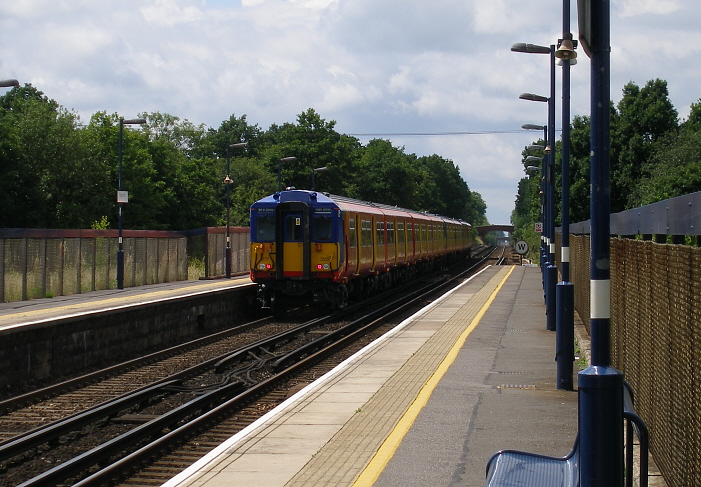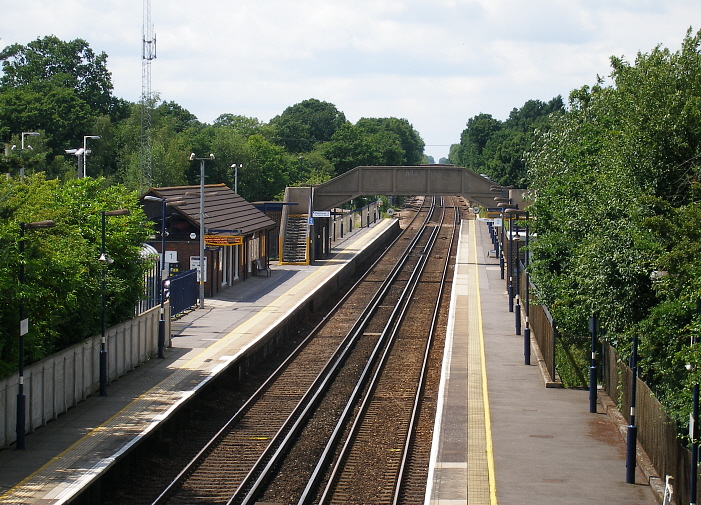
Staplehurst
Under SE&CR auspices, the simplification of the layout occurred. In general,
this saw the abolition of the wagon turntables and the removal of the
distinctive track, which intercepted the running lines at 90 degrees, on the
site of the track foot crossing. The ‘’up’’ side retained an eastward-facing
dock line, but this was fed by means of a conventional siding after a head shunt
manoeuvre. The Southern Railway was the next body to implement changes;
traditional gas lamps of a Victorian design were replaced by the company’s
trademark swan-neck types. This would merely appear to involve the removal of
the lamp’s existing head and the retention of the wrought-iron post. This lamp
replacement exercise seems to be arbitrary – Pluckley and Headcorn (despite the
latter’s 1930 enlargement works) retained SER-designed lamps until the advent of
British Railways’ electric lighting. The SR also added a substantial canopy
to Staplehurst’s ‘’up’’ waiting shelter in about 1930. Indeed, it was under BR
that the station was transformed beyond recognition. Unintended change occurred
in January 1960, when the main ‘’up’’ side timber station building was
obliterated by a fire outbreak. This marked the beginning of the end for all
SER-built structures, excluding the goods yard (for the time being). Strangely,
the destruction not only called for replacement waiting room structures, but it
also marked a rather premature end for the signal cabin. Single-storey
brown-brick flat-roofed buildings emerged on either platform during the course
of just over two years, but the arrangement on the ‘up’’ side was of particular
interest. On the platform surface was erected a single-storey signal cabin,
built to the same design as those ‘’power boxes’’ which had been appearing as
part of the Kent Coast Electrification Scheme. This formally took over from the
SER timber signal box on 1st April 1962. In retrospect, had the original
building not succumbed to fire, it probably would have been eliminated nearly
three decades later in a rebuilding exercise.
In the meantime, additional works had been in progress for the aforementioned
electrification. These included the erection of a prefabricated concrete
footbridge between platforms in 1961, to replace the existing track foot
crossing. Furthermore, the staggered nature of the platforms was also dispensed
with: this was achieved by extending the ‘’up’’ and ‘’down’’ surfaces with
prefabricated concrete at their eastern and western ends respectively. These
extensions allowed the eastern section of the ‘’down’’ platform, which resided
beyond the road bridge and was at a lower level to the rest of the surface, to
be taken out of use. Demolition of the water tower coincided with this. The
first scheduled electric services along the route commenced on 12th June 1961,
to existing steam timings, and the full accelerated timetable came into use on
18th June of the following year. The ‘’up’’ side goods yard remained in use
until 4th October 1971, coal remaining an important commodity until the end.
British Rail’s Business Sector era marked another period of change for
Staplehurst. In 1988, a new red brick pitched-roof single-storey station
building appeared on the ‘’up’’ platform, immediately east of the 1961-installed
footbridge. Similar structures were also incorporated into rebuilds at Marden
and Headcorn, and extensively along the Dartford Loop Line via Sidcup. Both
platforms at Staplehurst were further extended at their London ends in 1991, and
these were subsequently backed at their rears with wire mesh fencing. The
transformation of Staplehurst was now complete: the station had become a small,
modern affair, belying its SER past. Scheduled for 2008 is the addition of a
second footbridge, complete with lifts, to provide step-free access to the
''down'' platform as part of Network Rail's ''Railways for All'' programme.
Planned to be on the Ashford side of the main station building, its
prefabricated concrete predecessor, which resides at the London end of the
station building, will remain, until it needs repairs which cost more than
demolishing it (estimated at £40,000).
With thanks to Tom Burnham for Network Rail footbridge information.
22nd June 2007

A visitor to the line: Class 455 No. 455859 is observed passing through from Chart Leacon, on its way to Wimbledon,
on the South Western Division. These units were refurbished by ABB at the depot for South West Trains. There is
further evidence of platform lengthening here, such occurring during 1991. David Glasspool
22nd June 2007

Another westward view better illustrates the platform structures. The pitched-roof red-brick building is a far
cry from the CLASP abominations which began appearing in the late 1960s. The waiting room/signal box
block of 1962 is obscured by the footbridge's flight of stairs. The wired mesh fencing on the right dates from
1991. David Glasspool
Return to the Kent Rail Homepage or alternatively, check for Updates.
Website & Copyright information - Links - Contact the Webmaster
All content is copyright © David Glasspool